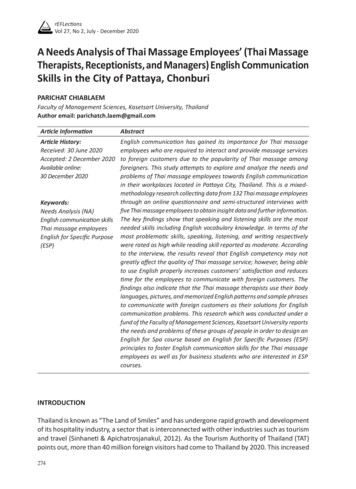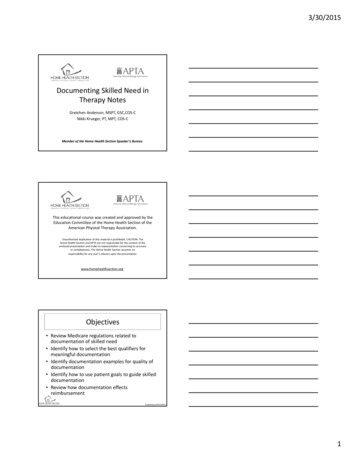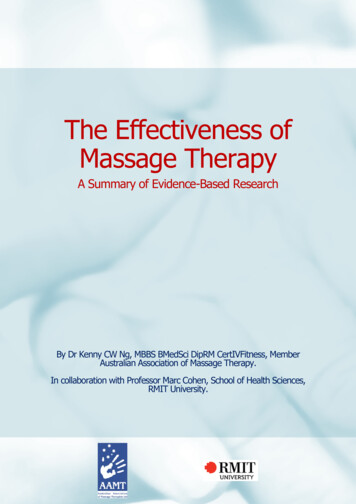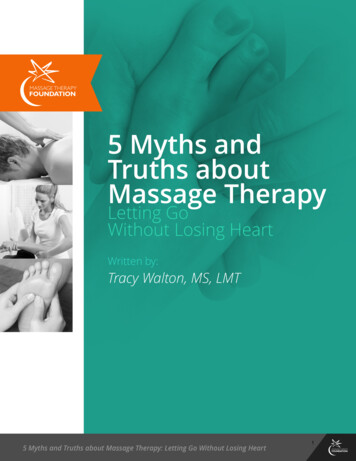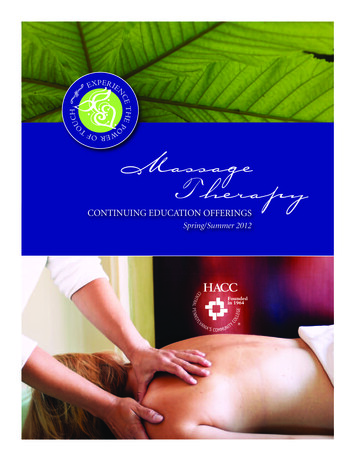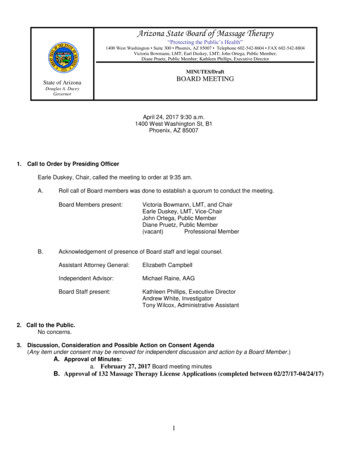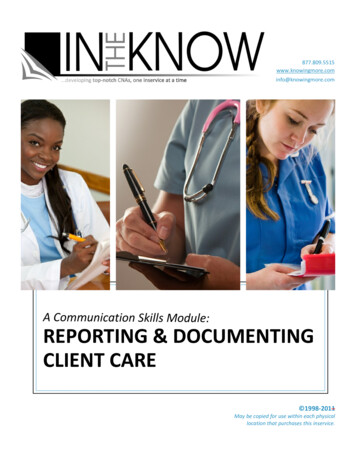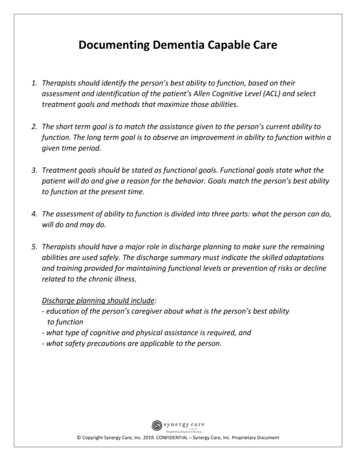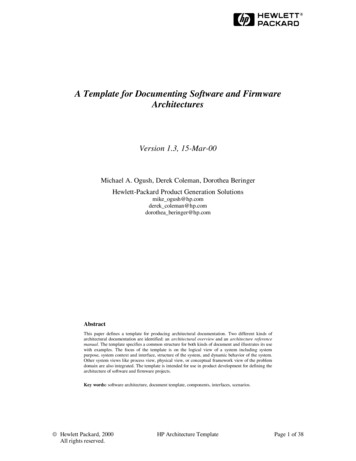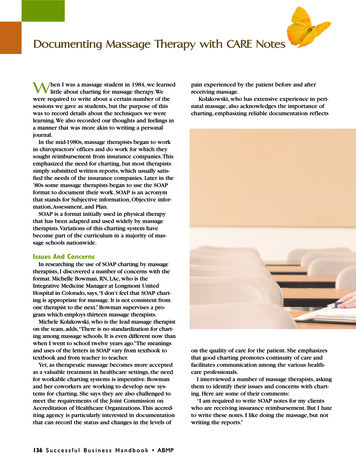
Transcription
Documenting Massage Therapy with CARE NotesWhen I was a massage student in 1984, we learnedlittle about charting for massage therapy.Wewere required to write about a certain number of thesessions we gave as students, but the purpose of thiswas to record details about the techniques we werelearning.We also recorded our thoughts and feelings ina manner that was more akin to writing a personaljournal.In the mid-1980s, massage therapists began to workin chiropractors’ offices and do work for which theysought reimbursement from insurance companies.Thisemphasized the need for charting, but most therapistssimply submitted written reports, which usually satisfied the needs of the insurance companies. Later in the’80s some massage therapists began to use the SOAPformat to document their work. SOAP is an acronymthat stands for Subjective information, Objective information,Assessment, and Plan.SOAP is a format initially used in physical therapythat has been adapted and used widely by massagetherapists.Variations of this charting system havebecome part of the curriculum in a majority of massage schools nationwide.pain experienced by the patient before and afterreceiving massage.Kolakowski, who has extensive experience in perinatal massage, also acknowledges the importance ofcharting, emphasizing reliable documentation reflectsIssues And ConcernsIn researching the use of SOAP charting by massagetherapists, I discovered a number of concerns with theformat. Michelle Bowman, RN, LAc, who is theIntegrative Medicine Manager at Longmont UnitedHospital in Colorado, says,“I don’t feel that SOAP charting is appropriate for massage. It is not consistent fromone therapist to the next.” Bowman supervises a program which employs thirteen massage therapists.Michele Kolakowski, who is the lead massage therapiston the team, adds,“There is no standardization for charting among massage schools. It is even different now thanwhen I went to school twelve years ago.”The meaningsand uses of the letters in SOAP vary from textbook totextbook and from teacher to teacher.Yet, as therapeutic massage becomes more acceptedas a valuable treatment in healthcare settings, the needfor workable charting systems is imperative. Bowmanand her coworkers are working to develop new systems for charting. She says they are also challenged tomeet the requirements of the Joint Commission onAccreditation of Healthcare Organizations.This accrediting agency is particularly interested in documentationthat can record the status and changes in the levels of136 S u c c e s s f u l B u s i n e s s H a n d b o o k ABMPon the quality of care for the patient. She emphasizesthat good charting promotes continuity of care andfacilitates communication among the various healthcare professionals.I interviewed a number of massage therapists, askingthem to identify their issues and concerns with charting. Here are some of their comments:“I am required to write SOAP notes for my clientswho are receiving insurance reimbursement. But I hateto write these notes. I like doing the massage, but notwriting the reports.”
“I’m not always sure what needs to be in a chart, andwhat might not be necessary.”“When I was in massage school, I learned to chart SOAPnotes, but I don’t use them in my private practice, so Iwouldn’t feel confident to use them if I had to.”One massage therapist, with five years of experienceas a physical therapy assistant, says the SOAP formatmakes sense for physical therapy where there are specific treatment goals, but that it didn’t seem relevant inher work doing relaxation massage in spa-type settings.Have we been using approaches that feel like hand-medowns from other systems, not our own?A Natural Way Of ChartingIt is possible to address these concerns and offer aformat for documenting massage that is easy for themassage therapist to learn and use, and that meets therequirements of different organizations.The implementation of CARE notes offers a solution that is based ona natural approach to communication.This flexibleguide allows for comprehensive detail when it’srequired. It also offers a simple format for conciselyrecording a massage session.The CARE note system is based on the use of the following categories to guide the therapist in recording thesession: C condition of client;A action taken;R response of client; E evaluation.The first three ofthese elements—C,A and R—provide the critical information about a session.They provide a picture of therecipient of the massage, what kind of work was doneand how the individual responded to that work.Thefourth element—E—can be optional, but it allows spaceto record overall observations, recommendations orquestions that arise from the session.CARE notes are completed after the session.We willexplore these elements in more detail, but first it isnecessary to look at the initial client intake, which isrecorded before the session.Client intake formAn initial session with a client should begin withcompletion of an intake form. Depending on your setting, these formats vary widely. If you work in a medicalsetting or massage clinic, they will provide a standardform or one will have already been completed for youto see. Some medical settings do not give the massagetherapist access to the patient’s chart. Rather, theyinform the therapist of specific details: e.g., the patient’sdiagnosis and current medical condition, contraindications and/or cautions for massage as well as specificareas of concern, or areas needing massage.The intake form includes the client’s name, gender,birthdate and session date. It also has space for: client’scontact information, address and phone number; medicalhistory and current health conditions; other therapiesand medications currently being used; lifestyle factors,including occupation, exercise and diet; prior experiencewith massage; and reasons for receiving massage now.Once an initial intake is completed, the session canbegin. Information in the client intake constitutes thefirst part of the client record. CARE notes are completedat the end of the first session and after every subsequentsession. Depending on the complexity of the client’scondition, the treatment you give and their response toABMP S u c c e s s f u l B u s i n e s s H a n d b o o k 137
Documenting Massage Therapy with CARE Notesit, CARE notes can be quite simple and concise orthey can be more lengthy or extensive.Information from the client intake or medical recordforms the basis for the first part of the CARE notes.Condition of the clientThis section of the chart records the current condition of the client. It should give an accurate picture ofthe person in the present, and answers the questions,“Who is the client?” and “How is the client now?”Thispart should include a concise summary of relevantmedical information from the client intake form. Itwill also list current conditions and complaints, areasof discomfort, pain or tension, as well as emotionalwell-being or state of mind. It records the clients’ reasons for wanting massage, and their goals or intentions for the session.This section can include a notation of physicaland/or emotional discomfort or pain before the session. For example, you can ask,“On a scale of one toten, with ten being the worst, how would youdescribe the pain you are feeling right now?”After thesession, you would ask this question again and recordthe answer in the response section of the CARE note.Example. Condition: Clara T, fifty-five-year-oldfemale, with a history of asthma, chronic pain fromcervical strain (due to a car accident in 1985), complains of pain in the area of right trapezius, overalltension in back, from shoulder to hip, more notableon right side. Intermittent pain in right sciatic nerveat piriformis, refers down right posterior leg.She works in sedentary job, commuting forty minutes to and from work daily. Minimal exercise. Shehas not received massage before. Interested in painrelief and overall relaxation, even though she voiceddoubt that massage could be helpful.Before session: physical pain or discomfort, 7(0 none; 10 highest level); emotional pain or discomfort, 8 (0 none; 10 highest level).Action takenThis section of the chart records the type of massage given, the length of hands-on treatment time andthe positions in which the client was situated (prone,supine, seated or side-lying). It includes a summary oftechniques used, and the parts of the body massaged.Example.Action: I performed a full-body sixtyminute massage. In prone position, using a face cradle,138 S u c c e s s f u l B u s i n e s s H a n d b o o k ABMPTips for Using CARE NotesHere are some things to think about when charting amassage session: Sign and date the chart. The massage therapist’s nameand signature, along with the date of the session,should always be on the chart.The completed chartcan then be given to one’s supervisor or kept forpersonal records. Complete the chart as soon as possible after the session.It’s easier to do while the experience is fresh.Withpractice, it should only take a few minutes to accurately complete all the details necessary. Keep in mind the person(s) who will read the chart. In thehospice organization where I work, the notes go in thepatient’s permanent record, but they are also read byseveral other people, including the nurse, the socialworker, the volunteer coordinator and the massagetherapy supervisor. In other settings or circumstancesyour notes could be read by other professionals including physicians, physical therapists, chiropractors, attorneys or insurance claims personnel. Use precise and correct medical terminology. Avoidvague or imprecise terms. It is best to use correctmedical terminology whenever possible. For example,“I massaged her stomach.”You probably mean tosay,“I massaged her abdominal region.”Also, be careful of intangible words like energy or energy work.For a medical record or a chart that will be read bysomeone working for an insurance company, it is bestto use words that describe exact anatomy, physiological responses or specific techniques of bodywork. Ofcourse, much of what happens in a massage therapysession is intangible or difficult to describe. Don’tworry about it. Just record what you can, keepingyour audience in mind. If you are not sure your notesare adequate or appropriate, ask your supervisor orsomeone else who reads them. Be aware of legal ramifications. When charting forinsurance purposes, it is important to document levels of physical and emotional pain and suffering. Ifthe client is being reimbursed for massage as part ofbasic personal injury protection coverages, documentthese sessions carefully. Record the work you do andchanges in the client’s condition relevant to the
C.A.R.E. NOTES for Massage TherapyTherapist NameDate /Client Name/AgeSettinginjury for which they are being compensated. Donot speculate about prior injuries or conditions. These records are confidential. Notes are to beread only by authorized people who are involvedin the patient’s care.They should be kept in asafe place where they are protected from anyoneelse’s view. Keep in mind your scope of practice. Be consistentwith your role as a massage therapist.You can makeobservations of the client, but you can not diagnosea condition. For example “anxiety” is a medical diagnosis.You can report when the client says,“I feelstressed out.” If you are trained in other aspects ofhealth education you may draw on that awareness.For example, you might suggest an exercise thatcan benefit the client, that they can practice to augment the benefit of the massage session. Avoid judgment. You can present the facts as yousee them, but avoid interpretations.As a massagetherapist you often receive information that noone else on the client’s care team has, so it isimportant to report those observations. Be careful with abbreviations and use of symbols. Keepin mind that the point of charting is to record thesession and communicate it with others when necessary.The use of abbreviations can be useful toexpedite charting, but be sure that everyone readingthe chart knows what the abbreviations mean. (Onesupervisor was alarmed to find the letters S.O.B. inthe chart of a frail eighty-five-year-old woman, untilshe realized that the letters meant “shortness ofbreath.”) Find lists of accepted abbreviations for thefacility where you work.You can refer to HandsHeal by Diana Thompson or a medical dictionary. You may use sentence fragments. It is okay to usefragments to save time and space when charting,but make sure they make sense to the reader.Thetest of an adequate sentence fragment is this: Canthe reader easily translate that fragment into a logical sentence that would be consistent with theflow of the information in the chart? For example,“Intermittent pain in right sciatic nerve” can easilybe understood as,“The client reports intermittentpain in the right sciatic nerve.”Condition of Client:(medical condition, physical discomfort orstate, etc.)areas of painor tension, emotionalBefore session: physicalpainAction taken:or discomfort (0 noneemotional pa10 highestin or discomflevel)ort (0 none10 highestlevel)(massage strokes performed, parts of body massaged, length of session, etc.)Response ofClient:(physiological changes noted during anback, verbald after the sefeedback, etcssion, nonver.)bal feedAfter session: physical painEvaluation:or discomfort (0 noneemotional pa10 highestin or discomflevel)ort (0 none10 highestlevel)(expectationsor plan for next session, retions to othercommendatiocaregivers, etcns to client, su.)gges Mary Kathleen Rose, CMT 2003 Write legibly. A chart that cannot be read is worthless. More people are typing now and plans areunderway in various facilities to computerizecharting. Nurses and physical therapists arealready using new programs for medical charting. Keep a personal journal of your work. Often youwill be the only person to read your CARE notes,particularly if th
SOAP is a format initially used in physical therapy that has been adapted and used widely by massage therapists.Variations of this charting system have become part of the curriculum in a majority of mas-sage schools nationwide. Issues And Concerns In researching the use of SOAP charting by massage therapists,I discovered a number of concerns with theFile Size: 547KBPage Count: 6
